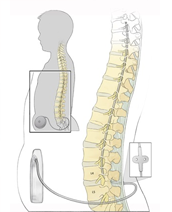Intrathecal Narcotic or Baclofen Pumps
 A Pump is a specialized device, which delivers concentrated amounts of medication(s) into the spinal cord area via a small catheter (tubing).
A Pump is a specialized device, which delivers concentrated amounts of medication(s) into the spinal cord area via a small catheter (tubing).
A Pump is offered to patients with:
Chronic and severe pain, who have not adequately responded to other treatment modalities. Some of the examples are failed back syndrome, cancer pain, RSD. These patients receive infusions of painkillers such as Morphine or Dilaudid. Spastic disorders such as Multiple Sclerosis, Spinal Cord Injury – associated with muscle spasms. These patients receive an infusion of an antispasmodic medication called Baclofen.
What is the purpose?
This device delivers concentrated amounts of medication into the spinal cord area allowing the patient to decrease or eliminate the need for oral medications. It delivers medication around the clock, thus eliminating or minimizing breakthrough pain and/or other symptoms.
How long does the procedure take?
It is done in two stages. In the first stage, a single injection is made to assess effectiveness and screen for unwanted side effects. If this trial is successful in relieving symptoms, then the permanent device is placed under the skin. The patients have to meet certain other screening criteria before implanting the pump.
Will the procedure hurt?
The procedure involves inserting a needle through the skin and deeper tissues (like a “tetanus shot”). So, there is some discomfort involved. However, we numb the skin and deeper tissues with a local anesthetic using a very thin needle prior to inserting the needle. Most of the patients also receive intravenous sedation and analgesia, which makes the procedure easy to tolerate.
Will I be “put out” for this procedure?
The placement of the tubing is done under local anesthesia with patients mildly sedated. The amount of sedation given generally depends upon the patient tolerance.
For the pump placement, patients are given stronger intravenous sedation and analgesia or general anesthesia if their health permits.
How is the procedure performed?
It is done with the patient lying on the side. Sometimes the tubing is placed with the patient sitting up. The patients are monitored with EKG, blood pressure cuff and blood oxygen-monitoring device. The skin is cleaned with an antiseptic solution and then the procedure is carried out. X-ray (fluoroscopy) is used to guide the needle for inserting the tubing.
Where is the tubing inserted? Where is the pump placed?
Tubing is inserted in the midline at the lower back. The pump is then placed on the side of the abdomen.
What should I expect after the procedure?
If the procedure is successful, you may feel that your pain may be controlled or quite less. The pump is adjusted electronically to deliver an adequate amount of medication.

